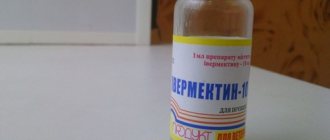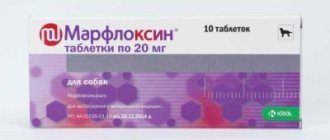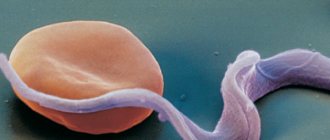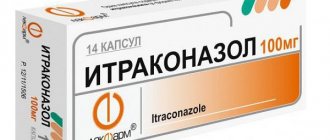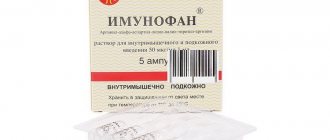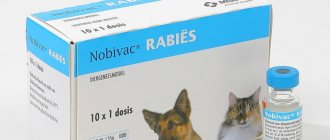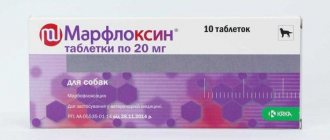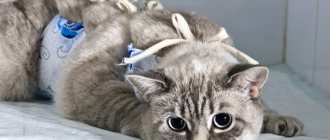A purr that appears in a house adds a lot of trouble to the owner. From the moment your pet is born, you should take care of the quality of its nutrition, care for its coat, potty train it, and monitor the timeliness of vaccinations.
Unfortunately, even those cats that live in an apartment can become the owners of parasites. Otodectin, which is actively used in veterinary medicine, is considered one of the most effective antiparasitic medications. The drug allows you to quickly rid your animal of worms and restore your pet’s health.
Composition and properties
The main active ingredients of the drug are ivermectin and dimethylcarbinol.
In addition, the composition contains a hygroscopic liquid necessary for disinfection. Manufacturers produce the drug in the form of a colorless injection solution. Glass bottles are sold in dosages of 1-20 ml, while plastic bottles are sold in dosages of 1.2 and 5 ml.
Ampoules are placed in the amount of 10 pieces in a cardboard package. Otodectin is intended for administration under the skin. Veterinarians recommend giving cats an injection in the forearm area.
The main mechanisms of the therapeutic effect of the drug include:
- Penetration of the active components of Otodectin into the muscle cells and nervous system of parasites, which makes it possible to influence the magnitude of the current of chlorine ions.
- Destruction of chains of nerve impulses that lead to paralysis of parasites.
- Destruction of mature individuals and their larvae.
- Maintaining the maximum degree of therapeutic effect after administration of the injection solution by subcutaneous method for 12-15 days.
- Excretion of the active components of Otodectin through bile, urine and milk.
Description of the drug Otodectin
Otodektin is a broad-spectrum drug that is used in veterinary medicine to treat parasitic diseases. The international name of the drug is ivermectin, but in Russia products with the name Otodectin are popular. The manufacturer of the drug is Russian, which specializes in the development and production of medicines for various animals.
Many pet stores and veterinary pharmacies offer customers medications from Vetbiohim LLC.
Vetbiohim occupies one of the leading positions among companies producing popular antiparasitic products. In addition to Otodectin, this organization produces such well-known drugs as Acaromectin, Trontsil and Tsiperil.
Release form of the drug
Otodectin is available as a sterile solution for injection. Externally, it is a colorless liquid, packaged in bottles made of colorless glass or plastic (1, 2, 5, 10 and 20 ml) or in glass ampoules (1, 2 or 5 ml). The bottles are sealed with rubber stoppers and covered with blue metal caps. Ampoules and bottles (except for units with a volume of 20 ml) are packed in cardboard boxes (10 pieces each). Each box comes with instructions for use.
The packaging box is made in gray and white, the labels on the bottles are red and white. The following information is indicated on the box and bottles:
- name of the drug, concentration;
- name of the manufacturer;
- number of bottles/ampoules and their volume;
- special instructions (“Sterile”, “Subcutaneous”, “For animals”);
- release date, expiration date (at the end of the package), etc.
Otodectin and other manufacturers may be found on the windows of some pharmacies. For example, CJSC Narvak previously produced medicine in the same form and with the same packaging; only the appearance of the box and bottle differed. The white cardboard box featured a red inverted triangle, and the bottle label was white with a blue stripe. The bottle cap was painted red.
On the packaging of Otodectin from Vetbiohim LLC there is a drawing in the form of molecules
Composition of Otodectin
The composition of 1 ml of antiparasitic medicine Otodectin includes the following components:
- ivermectin - 1 mg (active ingredient);
- isopropanol - 0.109 ml;
- triethylene glycol - up to 1 ml.
How to properly store medicine
Otodectin should be stored in accordance with the manufacturer's recommendations:
- separately from food and feed;
- in sealed manufacturer's packaging;
- away from heat sources and open flames;
- in a dry place protected from light;
- out of the reach of children;
- at a temperature not exceeding 30°C;
- Shelf life: 5 years from the date of production.
I recommend that all pet owners keep all veterinary medications in a separate first aid kit. I bought a large kitchen container especially for this purpose, which holds not only medicines, but also other important items (syringe, tourniquet, scissors, nail clippers, etc.). On top of the contents I put a notebook in which I paste instructions for all medications. This is very convenient, because using the old instructions you can independently decide on the medicine.
Characteristics of the medicine
It is recommended to store the medicine away from food in a place where there is no open sunlight. Otodectin can be stored for 5 years at a temperature of 22-25C.
The main pharmacological property of the drug is antiparasitic. The main active components of Otodectin actively fight against:
- larval and mature stages of nematodes;
- sarcoptoid mites;
- demodectic mites and other insects that a cat may have.
Disturbance in the conduction of nerve impulses leads to paralysis of parasites and their death.
Indications
Veterinarians use injections of the drug to treat ailments that are associated with parasites. Otodectin also has a high degree of effectiveness in treating:
- ear scabies;
- skin diseases, the development of which is provoked by mites;
- demodicosis (a small mite affects both the fur and skin of the cat);
- sarcoptic mange, accompanied by unbearable itching;
- damage to the body by worms;
- Medicine is also used to rid the animal of fleas and lice.
A number of the listed ailments do not have pronounced symptoms, which is extremely dangerous for the life of a furry friend. The pet owner, as a rule, cannot recognize the problem in time and therefore the cat does not receive timely treatment.
Parasites secrete saliva and waste products, which lead to the destruction of the tissue system of the four-legged pet's organs, which causes severe poisoning of the cat.
Contraindications
Despite the relative safety of the injection solution, the presence of ivermectin in the composition does not make it possible to use it to treat some cats. Otodectin can only be used as prescribed by a specialist in the field of veterinary medicine and in full compliance with the recommendations for its use listed in the instructions.
Otodectin injections are contraindicated:
- kittens whose age does not exceed 60 days;
- cats with individual intolerance to the active substances present in the composition;
- emaciated animals;
- cats that are suffering from an infectious disease at the time of taking the medication.
In case of overdose the following observations are possible:
- frequent bowel movements and urination;
- paw tremors;
- ataxia;
- severe drooling.
If one of the components of the medicine causes an allergic reaction, you should use an antihistamine.
Combining Otodectin for cats with other medications that contain ivermectin is prohibited!
Instructions for introduction
Otodectin is administered using a syringe with a short needle subcutaneously in the forearm of a sick animal. The dosage is calculated taking into account the body weight of the sick pet. For each kg of weight you will need 0.2 ml of injection solution.
One dose of the medication will get rid of helminths, but to remove fleas and ticks you will need 2 doses. The interval between injections should be 8-10 days. After the first injection, you should carefully treat the floor surface and wash all fabric surfaces on which the pet was lying.
It is very important to control the dosage of the drug. When processing an animal, it is necessary to observe aseptic measures and not touch the food. If your cat has an allergy, you should immediately consult a veterinarian.
Pros and cons compared to other means
The antiparasitic drug Otodectin has a number of advantages compared to other drugs:
- a wide spectrum of action allows it to be used in cases where a cat is infected with several parasites at once;
- medicine is used to control internal or external pests;
- the effect is on both larvae and adults;
- a short course of treatment is required (1-2 injections are enough).
The disadvantages include the presence of only one form of medication - when working with solutions, it is quite difficult to measure the required dosage. Some owners are afraid or do not know how to give injections to their pets, so they either take their cats to veterinary clinics for procedures, or look for other remedies in tablets and mixtures.
Otodectin is not suitable for prophylaxis; it can only be given if there is a confirmed parasitic infestation - therefore, before starting the course, you must be examined by a veterinarian
It is also important to note that Otodectin is poorly tolerated by kittens. Although the instructions indicate an age limit of 2 months, many breeders note in reviews that even six-month-old babies react negatively to the medicine, so it is still better to give it to adult, strong cats.
Table: comparison of Otodectin analogues
| Name and manufacturer | Shape and volume | Ivermectin dosage | Indications | Contraindications | Side effects | approximate price |
| Farmectin veterinary (Syria) | Solution 50 ml | 10 mg | Treatment and prevention of animals from invasive diseases caused by nematodes and ticks. |
| Not marked. | 78–85 rub. |
| Acaromectin (Russia) | Spray 25 ml | 0.1 mg | Treatment of demodicosis, notoedrosis, sarcoptic mange, otodectosis, entomosis caused by lice, fleas or lice-eaters. |
|
| 110–120 rub. |
| Ivermek (Russia) | Solution 50 ml | 10 mg | Prescribed to animals for therapeutic and prophylactic purposes for arachnoentomosis and nematodosis. |
|
| RUR 188–190 |
| Novomek (Russia) | Solution 10 ml | 10 mg | For parasitic diseases of animals (lice, bloodsuckers, causative agents of gadfly diseases, sarcoptoidosis, wolfharthiasis and helminthiases caused by nematodes). |
| At recommended doses it does not cause. | 720–730 rub. |
Photo gallery: analogue drugs
Farmectin contains 10 mg ivermectin
Ivermec should not be used during pregnancy.
The use of Novomek according to the instructions does not cause side effects
Acaromectin is available in spray form
Advantages and disadvantages of the drug
The main advantages of Otodectin:
- wide area of influence (kills various types of parasites);
- affordable price;
- achieving a quick effect;
- no side effects.
Among the disadvantages are:
- the impossibility of using kittens whose age has not reached 60 days for therapy;
- negative impact of the active substances contained in the composition on the body in case of overdose.
Price
A bottle with a dose of 5 ml can be purchased for 60-78 rubles. For 10 ml bottles you will have to pay at least 145 rubles.
Possible side effects and contraindications
Contraindications to the use of Otodectin are:
- age less than 60 days;
- presence of infectious diseases;
- weakness of the body due to past illnesses;
- exhaustion;
- individual intolerance to the components of the drug.
All my cats are “chosen cats.” As a matter of principle, I don’t “buy” kittens (no matter how much I would like to). So sometimes my charges turn out to be already infected. Of course I have to quarantine them. A separate problem is ridding new kittens and cats of fleas, ticks and helminths. Of course, I want to rid the poor creatures of the infection once and for all, but you need to choose antiparasitic agents with great care. My friends had a case where a wormed cat was treated with a strong anthelmintic. The parasites partially died, but for some reason they were unable to leave the animal’s body. Their decay products entered the blood of the already weakened cat, and she suffered severe intoxication. The cat survived, and people I know since then buy every medicine only with the permission of the veterinarian.
What to do in case of overdose
If you follow all the recommendations specified in the instructions, there will be no overdose. It can occur if the dosage of the drug is exceeded or the treatment regimen is incorrectly drawn up. In such cases, characteristic symptoms may appear:
- increased salivation;
- slight trembling;
- frequent visits to the toilet;
- motility disorders (inconsistency of movements, disorientation in space).
If one of these symptoms appears, you should contact your veterinarian. The use of Otodectin will be discontinued, and the animal may be prescribed antihistamines and/or symptomatic therapy.
Combination with other drugs
In most cases, Otodectin can be combined with other drugs. However, this must be done very carefully and only after the approval of a veterinarian. Otherwise, you can make a mistake that will lead to a deterioration in the health of your pet.
Combination of Otodectin with other medications:
- Ivermikol, Baymek, Vormil and other drugs containing ivermectin. Their simultaneous use with Otodectin will lead to the development of serious side effects.
- Roncoleukin, Aminosol and other immunomodulators. They can be combined with Otodectin only if the animal has a bacterial infection.
- Clavaseptin, Zoetis, Baytril. These and other antibiotics can be taken during treatment with Otodectin, but this should only be done if absolutely necessary.
- Acaricidal drugs for external use (Acarastop, Amitrazine). They are allowed to be used during treatment of a cat with Otodectin.
- Insecticides (Flystop, Trixie and others). They are also intended for external use, so they are not capable of harming the health of your pet.
Reviews from owners and veterinarian
Natalya, 51 years old, Vladivostok : “Our schnauzer became infected with scabies. Within a few days I scratched my ears and neck. The veterinarian did not recommend pills, but recommended Otodectin injections. Injected subcutaneously. The injections are painful but effective. The treatment gave a positive result. The wounds began to heal. The dog is happier."
Valentina, 34 years old, Ufa : “We spent the whole summer in the village, where our dog acquired a whole set of parasites. Tests showed the presence of helminths and fleas. Our pet has lost weight. Returning to the city, we went to the veterinarian, who prescribed Otodectin, antifungal tablets and vitamins.
I took the dog to the clinic for injections. The treatment lasted 2 weeks. All dog supplies were disinfected. Everything ended well - our pet is healthy again.”
Daria, 27 years old, Bryansk : “Our Doberman was diagnosed with a helminthic infestation and prescribed an Otodectin injection. The doctor warned about possible side effects, but the treatment went well. Repeated tests showed that there are no parasites.”
Kirill, 34 years old, veterinarian, Irkutsk : “Otodectin is an effective antiparasitic agent. Its scope of application is wide; it destroys many types of parasites. The drug has many advantages: a small number of side effects, a quick therapeutic effect, low cost, and is available in many pharmacies.
But there are also disadvantages - it cannot be used on puppies under 2 months old. An overdose is fraught with the development of negative symptoms, so you should carefully read the instructions or act in accordance with your doctor’s recommendations.”
Features of application
To ensure that the medicine used does not harm the health of the animal, it is necessary to administer it correctly and strictly follow the prescribed dosages. If you don’t do this, you can only worsen the cat’s condition and develop additional diseases.
Method of administration and dosage
Otodectin must be injected subcutaneously into the area of the forearm, withers or knee crease of the pet. This procedure can be performed independently or with the help of a veterinarian. The first option is more preferable, as it saves time and reduces financial costs. In this case, you will need to take measures that will help prevent harmful microorganisms from entering the wound.
The optimal dosage of Otodectin for cats is selected based on their weight. Because of this feature, you will need to weigh your pet before each procedure.
Recommended single doses of medication:
- The weight of a kitten is less than 1 kg - 0.2 ml.
- From 1 to 3 kg - 0.6 ml.
- From 3 to 5 kg - 1 ml.
- From 5 to 10 kg - 1.5 ml.
- More than 10 kg - 2 ml.
In the latter case, the maximum permissible daily allowance is used. If it is necessary to treat kittens or pregnant cats, dosages should be selected according to general rules.
Side effects
With frequent overdoses and an incorrectly designed treatment regimen, various side effects can develop. They will create additional difficulties and worsen the cat's condition. To prevent this from happening, you must adhere to the rules for using the medication and not neglect the advice of specialists.
Possible side effects:
- inconsistency of animal movements (ataxia);
- disorientation in space;
- frequent urination and bowel movements;
- slight trembling;
- increased salivation;
- rash on the surface of the skin;
- frequent scratching;
- nervous state.
Personal safety
In order to prevent negative consequences for the cat and its owners, precautions must be taken. These simple rules apply not only to the procedure for administering the drug, but also to the way of communicating with a sick animal.
Safety regulations:
- During the procedure, it is necessary to observe the rules of personal hygiene.
- It is forbidden to inject near the animal's food or water. Otherwise, drops of the substance may fall into the bowl and turn its contents into poison.
- You must not smoke or eat food during the procedure.
- To avoid accidental contact of Otodectin with the skin or mucous membrane of the eyes, it is necessary to wear gloves and safety glasses.
- If you come into contact with the solution, you should immediately rinse the affected area with plenty of warm water.
- After the injection, the wound on the animal’s body should be disinfected.
- After finishing work, you must wash your hands thoroughly with soap or any other similar product.
- If allergy symptoms appear in a cat or its owner, you should stop using the medicine and seek help from a clinic.
- Experts recommend limiting contact with a sick animal and blocking its access to human resting places (bed, sofa, etc.).
Price and analogues
Otodectin is an inexpensive remedy. The cost of a 5 ml bottle is about 65 rubles. The drug can be purchased at many veterinary pharmacies and clinics.
Products with similar effects to Otodectin:
- Ivermek. The advantage of the drug is that it is available in several dosage forms - injection solution, gel and spray. The cost of the solution is about 40 rubles, and external products are much more expensive - from 300 rubles. Ivermek has more contraindications than Otodectin.
- Novomek. The dosage form is a solution for injection. Cost - about 40 rubles. It has the same effect as Otodectin, because it contains the same active ingredient.
Otodectin is effective in the fight against parasites of all types. The drug is safe for dogs, but it is not recommended to use it without a veterinarian's prescription. Only a doctor can choose the correct dosage and course duration. It must be remembered that self-treatment can lead to the death of your pet.
Instructions for use of Amitrazine
The treatment regimen, dosage and other features of the use of Amitrazine depend on the diagnosis.
Amitrazine for otodectosis
For ear scabies, the solution is used 2 times (the break between uses is 7 days). This scheme is based on the life cycle of the tick. Ear mites live for 9 days, which means that all the laid larvae should hatch within a week. However, sometimes some individuals survive even after treatment, so in some cases it is recommended to repeat the procedure until the cat is completely cured. The exact course of treatment is determined by the veterinarian. Here is the sequence of actions when using Amitrazine:
- On the surface where you will carry out the procedure, you need to lay a diaper or piece of cloth.
- Moisten a swab or cotton ball with distilled water or a special lotion (for example, Bars). Some people use Amitrazine for this procedure, but some veterinarians consider this unsafe.
- Clean the ear from accumulated dirt.
- Approximately 10 drops of the drug, or 0.5 ml, should be instilled into the treated ear (the dosage can be increased or decreased on the recommendation of a veterinarian). If Amitrazine gets on an open wound in the ear, it may cause pain. Therefore, it is advisable to carry out the procedure together (someone must hold the animal).
- The ear should be folded in half (closed) and massaged at the base. This way the drug will be distributed more evenly over all internal surfaces.
- Treat the second ear using the same procedure.
- Disinfect the work surface.
Amitrazine for subcutaneous mites
A more complex procedure is considered to be treating a cat with demodicosis or notoedrosis. The dosage is calculated according to the following scheme: up to 0.5 ml per 1 kg of body weight. Sequencing:
- Prepare your cat. For convenience, you can cut your cat's hair (usually the affected areas are cut, taking up to 1 cm of uninfected skin).
- Treat the infected skin to remove scabs and dirt. It is convenient to do this with a swab dipped in warm water. First you need to add a little oil (calendula, tea tree, etc.) to the water.
- Amitrazine should be applied with a swab or piece of gauze, starting from the edges of the cropped area to the middle.
- Make sure that the animal does not lick the drug for at least 20 minutes. For this purpose, you can put an Elizabethan collar on your pet.
There was also a situation in our family when the cat needed a protective collar (veterinary cone), but there was no such thing in the pet store. I made a collar from a one and a half liter plastic bottle. Since I cut the bottle with a utility knife, the cuts were not very even and probably irritated the cat. A few hours later I removed this device from the poor thing. Later, when it was necessary to prevent the licking of some drug, I simply wrapped the cat in a blanket and held it in my arms.
Subcutaneous mites are microscopic, and their eggs do not respond to Amitrazine, so the drug only acts on adult parasites and their larvae. An infected cat needs to be treated with Amitrazine several times with a break of up to 3 days (no more than once a day). In the most difficult cases, the procedure must be repeated up to 5 times. The veterinarian decides to stop using the solution or extend the course of treatment based on the results of the examination.
A cat’s complete recovery can only be judged by test results, so observation at a veterinary clinic is highly advisable.
